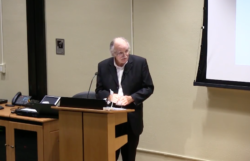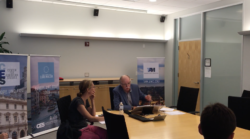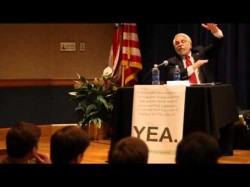Laying-Off Teachers To Demonstrate How Much They Are Appreciated
When the President came to Winston-Salem in North Carolina last December, and first laid out his “sputnik moment” analysis of our contemporary situation, the whole emphasis of his address that day was on the need to strengthen our educational base in order to compete effectively in the global economy of the twenty-first century. Using the analogy of flight, he was quite clear: “Cutting the deficit by cutting investments in areas like education [was] like trying to reduce the weight of an overloaded aircraft by removing its engine. It’s not a good idea. There may be some things you need to get rid of,” he said, “but you’ve got to keep the engine”.[1]
So you would expect, would you not, that when the next Teaching Appreciation Week rolled round – as it has just done – that across the length and breadth of this country teachers would be experiencing that appreciation through the confirmation of their job security or even the enhancement of their salary. You would expect it, but you would not find it. What you would find instead, in school district after school district, were teachers receiving notification that they were suddenly “surplus to requirement.” They were surplus to requirement not because they were doing their job badly – on the contrary, many of those now deemed surplus are national board certified teachers with stellar performance ratings. No, they are deemed surplus to requirement purely for budgetary reasons. The Winston-Salem/Forsyth County School’s proposed budget, for example, is so tight that it must eliminate 102 teaching positions and 165 other posts.[2] The equivalent budget in Charlotte-Mecklenburg will reportedly cost 700 employees their jobs and involve the redeployment of 340 more.[3] The hope of the Winston-Salem School Board is that most of those 102 teacher job cuts will be covered by retirements; but if they are not, then presumably layoffs must follow.
The detail no doubt varies between and even within school districts, but the overall reality is everywhere the same, as anyone with access to the social networks of the teaching profession knows only too well. Teacher unemployment is now the name of the game, and teachers with long years of service are particularly vulnerable: vulnerable because they are expensive relative to their underpaid younger colleagues, and vulnerable because finding fresh employment at their age will be particularly difficult. With the TARP money gone and the economy still in deep recession, those who govern us have apparently decided that the gutting of public education is now required to appease overseas creditors who might otherwise one day lose confidence in the security of U.S. Treasury bonds. That creditor-confidence hasn’t gone yet – on the contrary, the yield on three-month Treasury bonds is currently at a historic low and entirely stable[4] – but just in case it does, teachers of proven quality are everywhere going to the wall.
In Washington DC, a political conversation dominated by House Republicans focuses exclusively on issues of public debt and federal spending. John Boehner tells us daily that the deficit is America’s number one problem, and that trillions of dollars must be shaved off bloated federal budgets. What he doesn’t tell us, and I don’t hear the White House telling us and him either – certainly not in the volume and with the regularity required – is that the federal deficit in not our number one problem, and that immediately shaving off trillions of dollars from federal budgets would not solve it, even if it was. Indeed it could even make things worse.
Our number one problem now is recession – and what goes with that – unemployment and poverty, the insecurity of jobs and housing, and the erosion of vital public services at the level of the state and the county. And for that reason, we ought to be talking about more public spending, not less: spending targeted at the crisis of jobs, housing and services that is the daily reality of life in contemporary America, at least in the contemporary America that exists outside the Washington beltway.
- We have unemployment and poverty in contemporary America, both on an unprecedented scale. Though the economy added 244,000 jobs in April, the overall unemployment rate actually rose – from 8.8% to 9.0% – as total employment remained some 7 million jobs lower than in November 2007. At this rate, as Ezra Klein correctly observed, “We can add 244,000 jobs a month and not get back to pre-recession unemployment to 2016.”[5] And within the big number, there are some terrifying smaller ones too. Note the spike in filings for unemployment benefits in the last week in April (at 474, 000, the highest since last summer).[6] Note an unemployment rate among 16-24 year olds of 18.4%, among young high school graduates of 22.5%,[7] and among African-Americans as high as 19% in states like California.[8] Note the exposure of more and more Americans to long-term unemployment (currently 6 million out of work for more than 6 months and 4 million out of work for over a year).[9] Note the alarming shift of at least one million households from their previous status as two-income families in 2009 to their current dependency on just one salary in 2010;[10] and – tip of iceberg stuff, this – note the AAA report in April 2011 of an 18% increase since March 1 in the number of Americans running out of gas: running out in large measure presumably because they could no longer afford to drive with a full tank.[11] The poverty level in the United States remains officially 14.3% (some 43.6 million Americans, a third of whom are children). The near-poor are likely twice that number. America is bleeding at the bottom, and there is no sign of the hemorrhaging stopping any time soon.
- We have an on-going crisis of home foreclosures and negative equity, both of which are eating away at the speed of the economic recovery. In the first quarter of 2011, more than 28% of all U.S. homes were worth less than the mortgage outstanding on them, and more than three million new foreclosures were expected in 2012.[12] Three million foreclosed homes, to add to the 7 million foreclosed in similar fashion since this crisis began: a foreclosure tsunami which itself helps to hold down the price of existing homes, and hence the scale of negative equity. “Home prices have already dropped more since their peak in 2006 than during the Great Depression of the 1930s. Almost four in every ten homes sold today are sold by someone who either cannot pay their mortgage or will not because he or she owes more than the home is worth.”[13] Both the S&P/Case-Schiller 10-City and 20-City house price indexes fell steadily in the fall of 2010 and the winter of 2011, leaving house prices overall much where they were at the depth of the housing recession in April 2009.[14] The evidence is now overwhelming that the Obama administration’s HAMP[15] program has been a dismal failure – helping at most one struggling house-owner in four of the number who applied[16] – too timid in the character of the assistance offered, and too complex and bureaucratic in its mode of implementation. That program is in any case both in retreat and under Republican threat of defunding; so the housing crisis goes on, while the political class battle over a program never large enough, or sufficiently radical, to meet the task. Indeed the scale of HAMP’s failure is of truly historic proportions. “Of the $30 billion intended for the effort, only $1 billion has been spent so far to permanently modify 608,000 loans.”[17] Six hundred eight thousand loans, in a housing market with 10 million or more struggling consumers.
- We have corroding public services amid great private wealth, our own contemporary version of the old American capacity to combine private affluence with public squalor. There is certainly huge untapped private wealth in this country, entirely the product of the Reagan and Bush tax cuts and of the deliberate “decoupling of aggregate productivity and most workers’ wages.” [18] Take as evidence this recent data from Joseph Stiglitz, that: “As of 2008, the top 1% received over 20% of the total income earned by all Americans” and owned 42.7% of non-home wealth (stocks, bonds, other real estate, businesses and the like.”[19] There is also tax inequity. “New data released by the IRS reveals that, over a period of 12 years, tax rates for the richest 400 Americans were effectively cut in half” from 29.93% in 1995 to just 16.63% in 2007,”[20] but not for the rest of us. And there is also real chutzpah, at least at the top – the rich bouncing back, more prosperous than before, regardless of the depth and longevity of the recession affecting the rest of working America. Apparently “CEO pay now exceeds pre-recession levels…the typical pay package for the head of a company in the Standard & Poor’s 500 was $9m in 2010.”[21] Put all that alongside the fact that two-thirds of U.S. corporations currently pay literally no federal taxes,[22] and alongside the budget issued by one of the richest of all Americans – Mayor Blumberg of New York – the one proposing to lay off 5% of all schoolteachers in New York City.[23]Then you see what we have come to: huge untaxed private riches alongside major cuts in public services. Mix in rising health care costs and inherited pension commitments, and take out of any state budget equation the volume of federal aid now in decline; and you end up with state and local budgets that to varying degrees are in freefall.[24] But heaven forbid that anyone should mix back into the public accounting exercise any thought of increasing the tax-take from the rich, let alone any notion of more federal aid. To do either of those perfectly possible and absolutely vital things would fly in the face of trickle-down economics: and every Republican knows that trickle-down economics works, and works better than anything else![25]
- We have deficit reduction hawks who seem determined to talk us into the crisis of creditor-confidence that they then use to justify their hawkishness, and who gamble with our economic recovery simply to push partisan preoccupations that are entirely their own. This is not a recession caused by a federal deficit. It is a federal deficit caused by irresponsible tax cuts and the costs of foreign wars, amplified by the recession’s impact on tax revenues and its need for counter-cyclical public spending. Cutting that spending now will likely deepen the recession, by reducing direct purchasing by public agencies and the willingness of state employees to spend up to and beyond their income. (At about 15% of total demand, the spending of government employees is not something to cut lightly.[26]) In a recession caused by banking misbehavior and feckless mortgage practices, recovery requires both tight financial regulation (now in place but with Republican legislators seeking constantly to weaken it) and targeted public spending geared to the protection of vital social services and the strengthening of the long-term economic infrastructure. John Boehner’s cutting of trillions of dollars would only make sense if federal spending was out of control, was excessive, and was crowding out private sector borrowing. But it is none of those things, much to Boehner’s embarrassment. As The New York Times rightly put it on May 10th, “Mr. Boehner can’t admit all that because private-sector slack and a dearth of jobs call for more federal aid, not less. And he is bent on less – far less – no matter the true state of the economy.”[27]
The Republican program-cutters claim they have a mid-term mandate for their intransigence, though in truth I don’t remember any major Republican campaigning through the fall on the platform “vote for me and I’ll fire a teacher.” Maybe they did, and maybe I missed it; and anyway this level of political vandalism is all that we can legitimately expect from the modern Republican Party, infused as it is with Tea Party madness. But where is the Democratic Party push back, except from a few brave souls like Sherrod Brown and Harry Reid? Where is the voice of reason and sanity in this conversation? Where is the political leadership from the White House that would refuse to meet Cantor and Kyl in Blair House to explore areas of mutual agreement; and would instead insist on telling the American people – directly and over the heads of the Congressional Republicans – that cutting teachers of quality from an already underfunded public school system is sheer economic lunacy? At what moment will triangulation stop and the Republican bluff be called? At what point will the President of the United States tell the Speaker of the House of Representatives that teacher appreciation is vital to the long-term economic health of this country, and that taxing the Republican Party’s rich backers to fund that appreciation is America’s best hope for a first class educational and economic future?
That point ought to be now.
“Making the Progressive Case: Towards a Stronger American Economy”, on which this opinion piece draws, will be published by Continuum Books on June 9th
[1] For the detail of that address, see https://www.davidcoates.net/2010/12/09/president-obama-and-this-generation%E2%80%99s-%E2%80%9Csputnik-moment%E2%80%9D/
[2] Details at http://www2.journalnow.com/news/2011/may/12/wsmain01-school-employees-say-cuts-would-hurt-ar-1025733/?referer=None&shorturl=http://bit.ly/ku6B4k
[4] Reported in David Paul, “Default is Not in Our Future,” The Huffington Post, May 10, 2011: available at http://www.huffingtonpost.com/david-paul/default-is-not-in-our-fut_b_859769.html
[5] Ezra Klein, The last jobs plan in Washington, posted on The Washington Post blogsite, May 6, 2011, available at: http://www.washingtonpost.com/blogs/ezra-klein/post/the-last-jobs-plans-in-washington/2011/05/03/AFYNCB9F_blog.html
[6] Jeff Bater & Luca Di Leo, “Claims by Jobless Surge,” The Wall Street Journal, May 6, 2011
[7] See Heidi Shierholz and Kathryn Anne Edwards, The Class of 2011, Economic Policy Institute Briefing Paper #306, April 20, 2011: available at http://www.epi.org/publications/entry/bp306-class-of-2011/
[8] See Algernon Austin, Depressed States, Economic Policy Institute Issue Brief #299, April 20, 2011: available at http://www.epi.org/publications/entry/ib299
[9] See Paul Krugman, “Fears and Failure,” The New York Times, May 5, 2011
[10] See Heather Boushey, Not Working: Unemployment Among Married Couples, Center for American Progress, May 6, 2011: available at http://www.americanprogress.org/issues/2011/05/marital_unemployment.html; and Louis Uchitelle, “The Decline of the Two-Breadwinner Family,” The Nation, May 10, 2011: available at http://www.alternet.org/economy/150871/the_decline_of_the_%26quot%3Btwo_breadwinner%26quot%3B_family%3A_how_long-term_unemployment_threatens_to_demolish_the_middle_class
[11] Reported by Sami Grover on alternet.org, April 25, 2011: available at http://www.alternet.org/newsandviews/569771
[12] Ariana Huffington, “Minds on Jobs?” The Huffington Post, May 10, 2011: available at http://www.huffingtonpost.com/arianna-huffington/obama-jobs-economy_b_860026.html?utm_source=DailyBrief&utm_campaign=051111&utm_medium=email&utm_content=FeatureTitle&utm_term=Daily%20Brief
[13] Suzanne Kapner, “Homes barometer swings to danger,” The Financial Times, March 25, 2011
[14] Conor Dougherty & Nick Timiraos, “House Prices Near Recession Low,” The Wall Street Journal, April 27, 2011
[15] Home Affordable Modification Program, launched in February 2009
[16] Alan Zibel & Louise Radnofsky, “Only 1 in 4 Got Mortgage Relief,” The Wall Street Journal, February 28, 2011
[17] “Foreclosure follies,” editorial in The New York Times, March 3, 2011
[18] Jacob S. Hacker, The Institutional Foundations of Middle-Class Democracy: – a must read, posted May 6, 2011 and available at: http://www.policy-network.net/articles/3998/The-institutional-foundations-of-middle-class-democracy
[19] As reported by Leon Friedman, “Fixing the Deficit by Getting Help From the Top 1%,” The Huffington Post, April 19, 2011: available at http://www.huffingtonpost.com/leon-friedman/fixing-the-deficit-by-get_b_850655.html. The original article, in Vanity Fair, should be essential reading for all. It is available at: http://www.vanityfair.com/society/features/2011/05/top-one-percent-201105?printable=true
It includes this very perceptive observation. “Of all the costs imposed on our society by the top 1 percent, perhaps the greatest is this: the erosion of our sense of identity, in which fair play, equality of opportunity, and a sense of community are so important.” Please read it.
[20] Judd Legum, posted on alternet.org, April 18, 2011: available at http://www.alternet.org/newsandviews/562984
[21] Rachel Beck, “CEO Pay Now Exceeds Pre-Recession Levels,” The Huffington Post, May 6, 2011: available at http://www.huffingtonpost.com/2011/05/06/ceo-pay-high-pre-recession_n_858430.html
[22] Allison Kilkenny, “2/3rds of US Corporations Pay Zero Federal Taxes,” The Nation, March 28, 2011: available at http://www.alternet.org/story/150387
[23] Details in David Chen & Javier Hernandez, “Mayor’s Budget Seeks to Lay Off 5% of Teachers,” The New York Times, May 6, 2011
[24] “Forty four states and the District of Columbia are projecting $122 billion in budget shortfalls for fiscal 2012, according to the Center on Budget and Policy Priorities, which reports that nearly every state plans to spend less in 2012 than in 2008, after inflation.” (Marsha Mercer, Going Broke, aarp.org/bulletin/ May 2011
[25] For the evidence that it does not work, see David Coates, Answering Back: Liberal Responses to Conservative Arguments, New York, Continuum Books, 2010, pp. 34-56
[26] Kris Maher, “States’ Pay Cuts Present Mixed Economic Blessing,” The Wall Street Journal, May 2, 2011
[27] “Republican Demands and the Debt Limit,” editorial in The New York Times, May 10, 2011
David Coates holds the Worrell Chair in Anglo-American Studies at Wake Forest University. He is the author of Answering Back: Liberal Responses to Conservative Arguments, New York: Continuum Books, 2010.
He writes here in a personal capacity.






Winston Salem » Blog Archive » Laying-Off Teachers To Demonstrate How Much They Are Appreciated says:
[…] — on a contrary, a produce on three-month Treasury holds is now during a ancestral low and entirely stable — yet usually in box it does, teachers of proven peculiarity are everywhere going to a […]
Jack Reidy says:
Hi David,
Not sure what the previous comment means. But I do agree with you that the recovery is much more important than the extreme budget cuts going on now. in the long run I see that is is important to balance the budget but now is not the time.
I don’t think it is possible to budget-cut our way out of this recession. We need to invest in the future especially the education of our children.
I don’t think all the budget cutting going on has much to do with support of treasury bonds. Since many of the politicians playing chicken with our nation debt ceiling which will have an impact on the national credit rating than paying teachers, it seems that those laying-off teachers have a different agenda.
I enjoy stopping by to read your blog now and then since it is both well-written and well-documented. (As a retired scientist I appreciated both.)
Jack
Patricia Dixon says:
Well said David, now experienced teachers who are at the heart of building the next generation that will inherit the problems we are leaving behind, are being forced into early retirement. It is not enough that our college graduates have debts that exceed a trillion dollars and cannot find jobs this year, now we are eroding the education of our younger students at the expense of the GOP agenda to cut the deficit. This is a direct attack on the promise of the American Dream that is closely connected to “EDUCATION”.